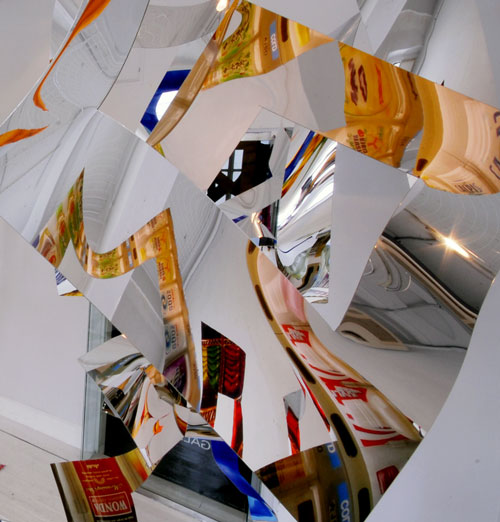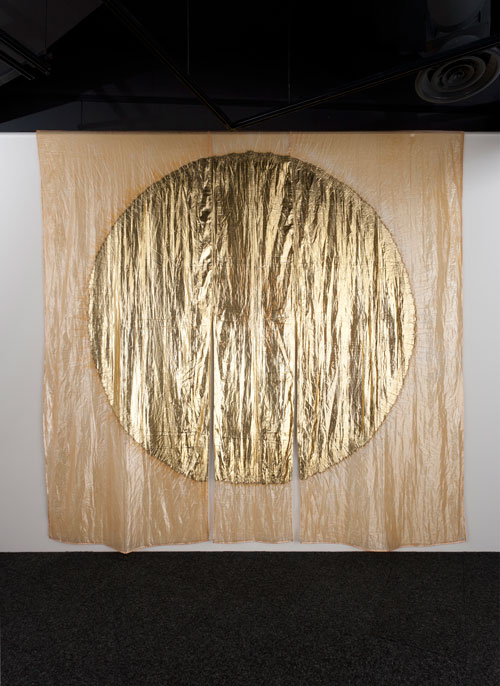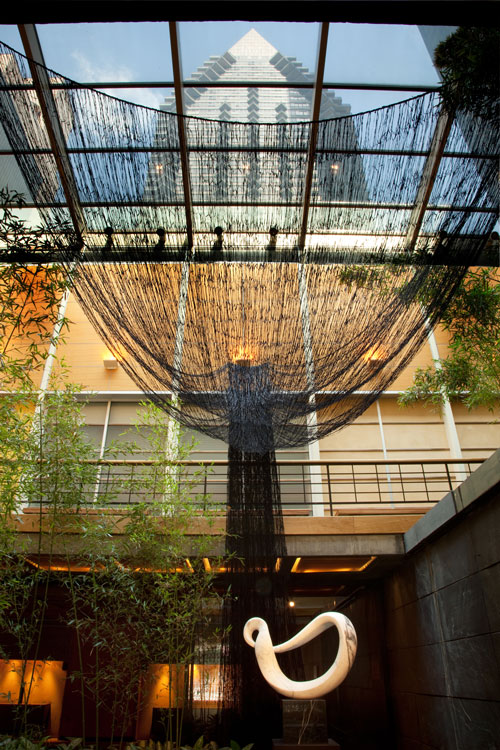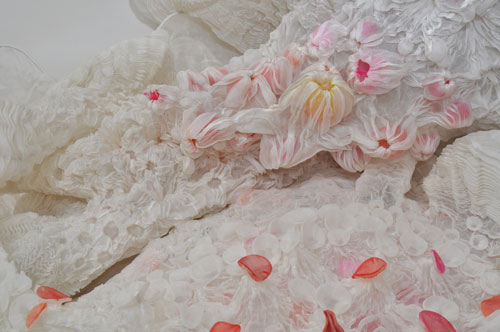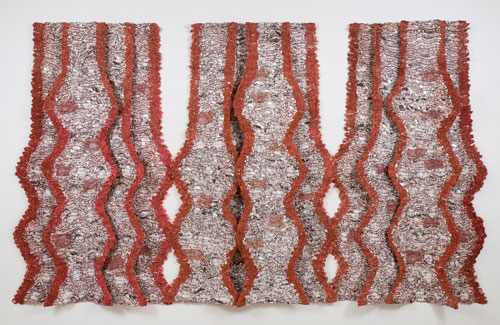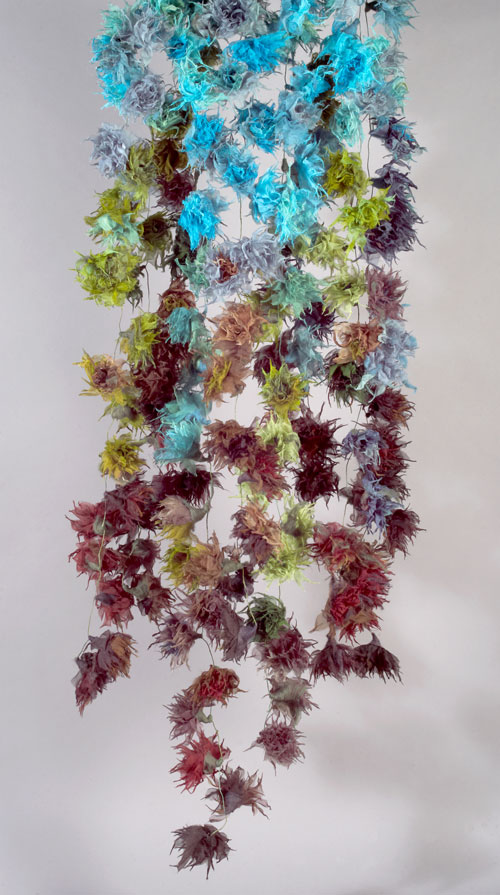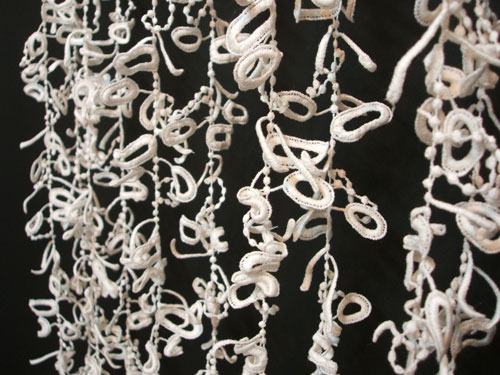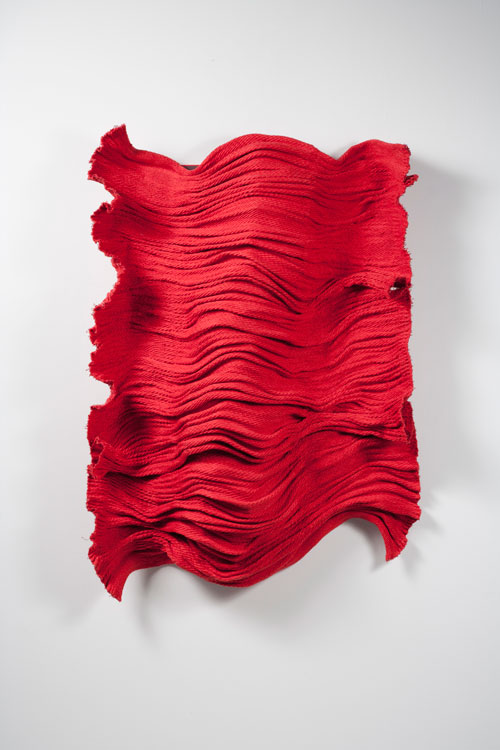

Fiber Futures: Japan’s Textile Pioneers
Japan Society Gallery, New York
16 September–18 December 2011
by CINDI Di MARZO
Because fibre can be made into such a variety of forms and used for myriad purposes, it is powerful. The artists featured in the juried show Fiber Futures, now on view at Japan Society Gallery in New York City, are pioneers of fibre art. From the oldest – esteemed renegade of the textile world Jun’ichi Arai (b1932) – to the youngest – Rei Saito (b1978), who explores the deeper meanings in common objects and memories – each of the 30 artists bows to the inherent potential and experimental possibilities of fibre.
Often, the connections formed in the 35 large-scale exhibited works are between human beings and the natural environment. Even when fashioned from metals, synthetics and technologically advanced materials – stainless steel, aluminum, polyester, flame-resistant polyphenylene sulfide (PPS), chemical pulp, etc – the works resemble natural shapes or inspire images of earth, sea and sky. Drawing on their craft heritage (basket-making, sewing, weaving, dyeing), some artists are employing traditional techniques on antique paper, mulberry fibre, flax, sisal hemp, bark, jute, cotton, wool and silk. Such materials offer flexible fibres that can be soft, smooth and transparent or hard, rough and solid.
The exhibit is a collaborative effort between Japan Society Gallery, Tama Art University Museum and International Textile Network Japan. In the catalogue, Hiroko Watanabe, a professor at Tama Art University and president of International Textile Network Japan, provides a long-range view of contemporary Japanese fibre art as a link between fine art, craft and design. Watanabe’s Red Pulse, a woven wall sculpture made of cotton and metal fibre, dyed a fierce red (“a mysterious colour that embodies both yang and yin,” she states), was selected for the show.
Typically, exhibits at the gallery are designed to grab visitors from the moment they enter the building. This time, the gallery commissioned paper artist Kyoko Ibe to create a hanging installation above the lobby garden pool. Ibe’s installations take advantage of wind currents and reflecting surfaces in the spaces where they will be seen. In this case, the artist used indigo-dyed threads to spin a web of shimmering light, which catches the shifts and shadows from the water below.
Machiko Agano’s untitled five-piece installation, made from inkjet printed mirror sheet, is another attempt to arrest the eye with reflections. But here, it is everyday chaos rather than idyllic serenity that is being courted. For much of her career, Agano has used bamboo, wood, sisal and other organic materials. Originally, she was trained as a weaver. This 2011 installation is a departure, in which she offers viewers “a vivid sense of the anxieties and inconsistencies inherent in the way we live today”, as she writes in her artist statement.
Jun’ichi Arai’s inclusion in the show is critical, as he is a seminal figure in the textile world. In the 1970s and 1980s, he developed previously unimaginable fabrics for the fashion houses of Issey Miyake and Comme des Garçons. He holds nearly 40 patents and is driven by the search for fabrics of the future. Arai is fascinated by the nexus between computer technology and traditional techniques, and focused on how a fabric performs as it moves and reflects light. His “flame-resistant shop curtain” is made of PPS film and vacuum-deposited aluminum. The catalogue describes PPS film and the intricate method by which the artist achieves his desired effects. Those whose understanding of the technical terms is vague should not worry. One need only look at the curtain to see that Arai is a genius.
In 1984, Reiko Sudo co-founded Nuno design house with Arai. She takes an inclusive approach to media and has used everything from stainless steel and aluminum to bamboo and bird feathers, while applying corrosive finishes that reveal underlying characteristics. Arai left Nuno in 1987, while Sudo continues as creative director.
Her white cotton “Fabrication” displayed in the gallery looks like an elaborate daisy chain. For it, she and her team strung tightly embroidered warps of cotton over metal rods to make strips of cotton tape. They sewed the strips together and used them to make what she calls an “aerial sketch.” In her catalogue statement, Sudo explains:
“The finished work seems to float freely in space, not only weaving together the ambient space, time, sounds, scents and light, but also, I hope, creating new relationships with viewers as they come and go.”
Yuh Okano also works in textiles. Like Arai and Sudo, Okano combines tradition and innovation to produce work that is, ultimately, a link with the natural world. For example, her Flower: Coming Events Cast Their Shadows Before, made of silk partially felted with raw wool and hand-formed into corsages, is a cascading waterfall of blooms. She also shows a “water” work in which the shibori tie-dying and devore finishing techniques are employed to achieve a breathtakingly tarnished beauty.
Each of the 30 works in Fiber Futures is a unique expression of a very basic, common denominator. As unlikely as it may seem, Yasuko Iyanaga’s A Gift from the Sea, a spun silk and wire sculpture resembling a coral formation, and Akio Hamatani’s W-Orbit, an indigo-dyed rayon installation measuring 400 cm in diameter, share a bond with Emiko Nakano’s Range: Cambodian Letters, a tapestry shaped like a series of Buddhist pagodas made from woven Japanese paper and silk.
Remarking on the far-ranging practices showcased in the exhibit, Japan Society Gallery Director Joe Earle said:
“Japanese fibre art today blends an incredibly rich, diverse and long-lived indigenous craft tradition with new ideas about the expressive possibilities of fibre as an art medium that emerged in Europe and America during the 1950s and 1960s. The results of this combination are amazing diversity; a willingness to explore materials as unexpected as stainless-steel wire, pulverised cocoons or newspaper; and that distinctive, careful dialogue with materials and processes which continues to mark out contemporary Japanese art.”
The visual diversity is sometimes disconcerting but in every instance remarkable. In the spirit of tariki, fibre is shown to transform even as it is transformed, and to connect disparate elements and people in a dialogue worth pursuing.
